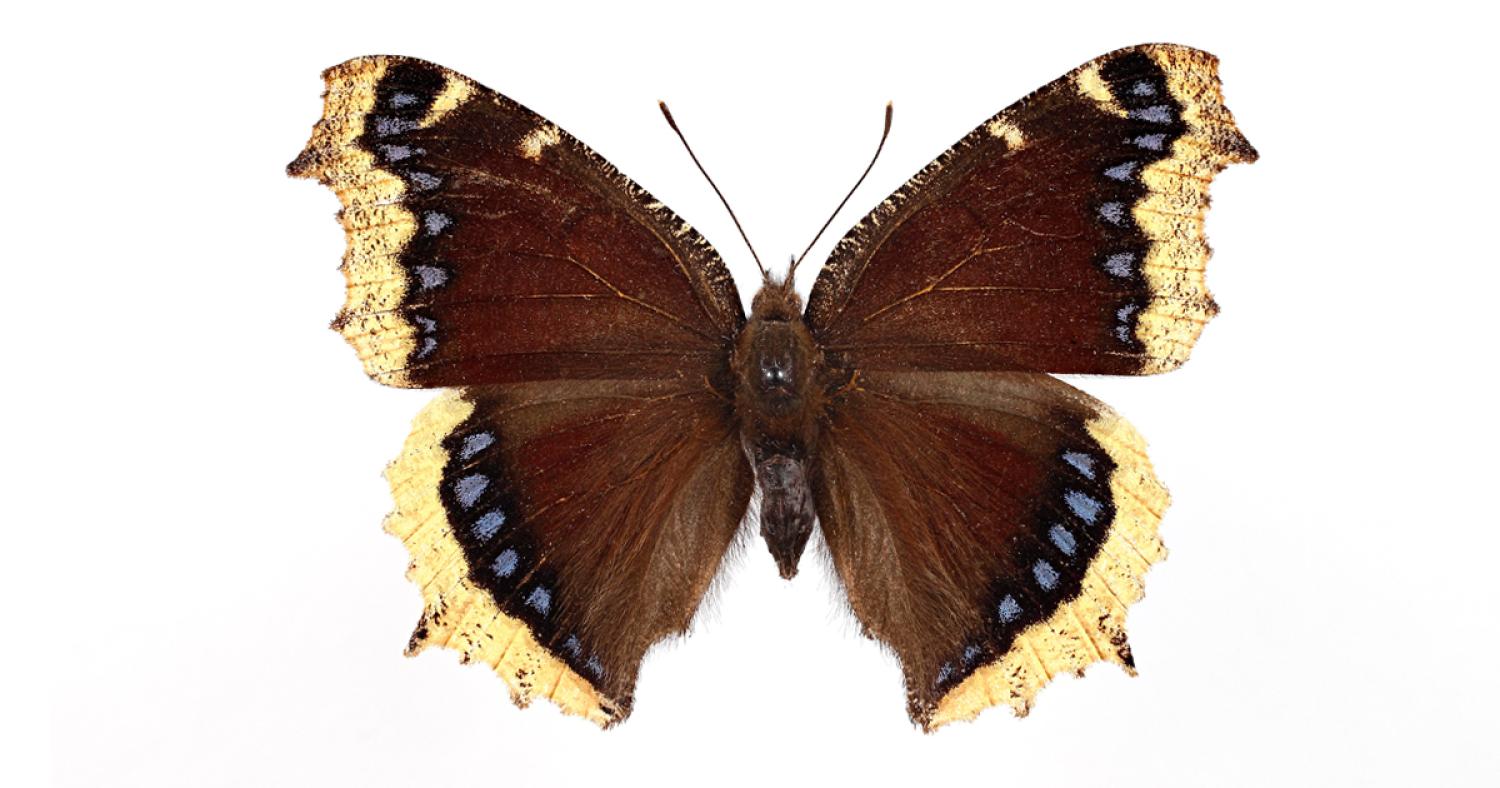The CU Museum is closed. We will be reopening soon.
During this time, collection visits will be available by appointment and other special access requests will be considered on a case-by-case basis.
Please email cumuseum@colorado.edu for more information.
Mourning Cloak Butterfly
The Mourning Cloak Butterfly (Nymphalis antiopoa ) is one of the earliest (and the latest) flying butterflies in its native range, which spans widely across temperate North America and Eurasia. These butterflies are relatively large, with up to 4” wingspans. Their wings are purplish black with a bright yellow margin and one set of iridescent blue dots around the edges of both sets of wings. The common name “Mourning Cloak” is similar in many languages throughout its range, referring to the darkened wing color representing a cloak, and the yellow margin as the fringe of a yellow dress worn underneath the cloak.
Like all butterflies and moths, the Mourning Cloak undergoes complete metamorphosis consisting of four stages: first as an egg laid upon a host plant, which hatches into a caterpillar that feeds on leaves, then pupates into a chrysalis, and finally emerges as a butterfly. The Mourning Cloak’s host plants, or the plants eaten by very hungry caterpillars, include willow, elm, cottonwood, aspen, birch, and hackberry.
This butterfly flies so early in the spring because it passes the winter months as an adult butterfly, overwintering in hollow trees or other protected areas, and flies whenever it is warm enough. In contrast to the Mourning Cloak, most butterflies weather the cold winter months as caterpillars or in their chrysalis and take longer to emerge as adults. On a warm winter day, it is possible to see these butterflies flying in search of sugary tree sap, the carbohydrate source that sustains them. When temperatures drop again, they will quickly return to their overwintering site until it gets warm again. It is common to see these butterflies on warm, sunny winter days. Upon the arrival of spring, the butterflies will come out of hibernation for the last time, mate, and the cycle begins again.
Mourning Cloak males are territorial. They perch and periodically make patrolling flights through their territory. If an invader passes through their territory, they will fly towards them. This past spring, a day-flying bat was observed encroaching on Mourning Cloak territory. As the bat flew through their space, two butterflies flew after it!
The specimen pictured was captured on Colorado’s Lookout Mountain by the well-known lepidopterist, Donald Eff, one of the three authors of Colorado Butterflies. The CU Museum of Natural History acquired his collection and field notes about 30 years ago. These specimens and notes are still regularly referenced by other Lepidoptera researchers around the country.
Holland, W. J. (1898). The Butterfly Book. Doubleday & McClure Co.
Anich, N. M., White, J. P., & Anich, S. E. (2020). Interspecific Territorial Behavior of Two Mourning Cloaks (Nymphalis antiopa) in Response to a Diurnally Active Big Brown Bat (Eptesicus fuscus). Northeastern Naturalist, 27(3).
Brown, F. M., Eff, J. D., & Rotger, B. (1956). Colorado Butterflies. Proc. Denver Mus. Nat. Hist.
Common name: Mourning Cloak
Scientific name: Nymphalis antiopoa L. (Family: Nymphalidae)
Catalog number: UCMC 0197164
Label data: USA: Jefferson County Colorado; Lookout Mountain; 25 June 1974, Donald Eff


